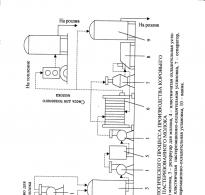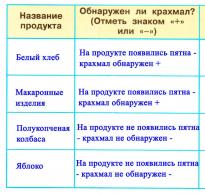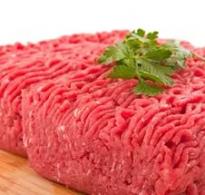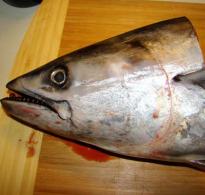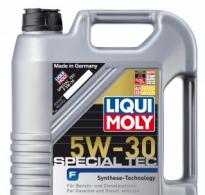Soda vinegar proportions. An effective method for quenching soda
To extinguish baking soda with vinegar you will need baking soda and white vinegar 9%. When we mix them together (sodium bicarbonate, hydrogen and acetate ions), a chemical reaction occurs. Ingredients boil, foam and bubble. This is due to carbon dioxide.
A pastry without this chemical reaction will not turn out fluffy, which means it will not be tasty. And if you want to know how to extinguish soda with vinegar, first read below about all the advantages of this venture.
| Soda + Vinegar | Soda + high temperatures from 60 ° C to 200 ° C | ||
| The unpleasant taste of "soap" is neutralized | + | If the baked goods do not contain oxidizing ingredients (sour cream, kefir, whey, etc.), a trace of soapy taste is possible | — |
| Sodium acetate is formed from a chemical reaction | — | decomposes into sodium carbonate, carbon dioxide and water | + |
| Carbon dioxide is released into the air, so the baked goods are not what you would like. | — | Carbon dioxide remains in the dough, and due to the effect of high temperatures loosens the entire volume of the dough | + |
| NaHCO3 + CH3COO H → CH3COONa + CO2 + H2O | 2NaHCO3 → Na2CO3 + H2O + CO2 |
Bottom line: As you can see, quenching soda with vinegar has more disadvantages than advantages.
Why extinguish soda with vinegar
Many housewives do not think about such a question, but in vain. The whole secret is that if you do not extinguish the soda with vinegar, the finished baked goods have a specific taste that resembles soap.
How to extinguish baking soda with vinegar to loosen the dough?
A chemical reaction (with the release of carbon dioxide) requires an acidic environment. It is created using vinegar or acidic ingredients such as citrus juice, sour cream, kefir, buttermilk, chocolate, cocoa, honey, Brown sugar, fruit.
To prepare recipes with these products, you can only use soda powder (no quenching). It is necessary to observe the exact proportions of the ingredients and not to overdo it with sodium bicarbonate.
What vinegar to extinguish soda
For baking, white (9%), wine or Apple vinegar... The first of them has a somewhat harsh taste, so it is used for making non-sweet pastries: pancakes, pies.
Apple cider vinegar has a fruity aroma and mild taste... It is preferable to use it in recipes for cakes, muffins, sweet tarts and cookies.
How to extinguish baking soda with vinegar for cakes, muffins
There are two important things to keep in mind to make your cakes, cupcakes or cookies fluffy:
- soda is mixed with flour (not vinegar);
- vinegar is diluted with water and then poured into the dough.
Those. The vinegar should be added to the baking soda and stir well. This should be done if the recipe does not contain sour ingredients that could extinguish the soda during the preparation process.
Many housewives, who usually get a bad baking, quench the soda powder in a spoon or glass, which is completely pointless. In both cases, carbon dioxide escapes into the air. If it forms inside the dough, then it loosens its entire volume.
Part of sodium bicarbonate is extinguished at the first stage (when kneading), and the outstanding part decomposes under the influence of high temperatures during baking, giving it additional porosity.
How can you extinguish soda if there is no vinegar
You can extinguish soda powder with citric acid (for 1 tsp of soda, you need to take 1 ½ tsp of acid). In the absence of acid, they manage with lemon juice. To do this, add 1 teaspoon of baking soda and 9 teaspoons of lemon juice per cup of flour (250 gr.).
For the preparation of children's or diet desserts, use citrus juice, chocolate, cocoa, honey, or fruit.
Now you know how to extinguish soda with vinegar, which means you can delight your loved ones with delicious pastries.
- Too much baking soda makes the dough taste bitter.(besides the soapy flavor). In addition, during a chemical reaction, very large bubbles are formed, which do not loosen, but burst. The dough rises instantly, but also falls quickly. The cake or pie turns out to be tough, without volume;
- If you by mistake (out of good intentions) replace kefir fresh milk, then no emission of carbon dioxide will occur. As a result, the baking will turn out not lush and with the same known unpleasant (soapy) taste.
Many housewives are already accustomed to pampering their household in the morning. delicious pancakes and pancakes. But at the same time, many add soda quenched with vinegar to the dough. In fact, this is not entirely correct. In this article, we will figure out how to extinguish soda.
This means that a chemical reaction has occurred between sodium bicarbonate and acetic acid, producing carbon dioxide. This gas raises the dough.
It should be understood that if the recipe indicates the use of sour milk or kefir, then there is no point in introducing vinegar.
This is necessary to give confectionery pomp and airiness. Some recipes don't need vinegar at all. This happens if the acid is used spoiled milk or kefir.
In general, the whole process is quite absurd. Most housewives just take and pour baking soda into a spoon and pour vinegar into it, observing the bubbles. What's really going on? The chemical reaction between sodium bicarbonate and vinegar produces carbon dioxide. But in order for the dough to rise and become fluffy, the reaction should ideally take place in the dough.


As we found out, it is wrong to quench sodium bicarbonate with vinegar in a spoon. After all, it will turn out that most of the bubbles will simply evaporate and the dough will not rise properly. That is why it is necessary to extinguish sodium bicarbonate correctly.
Instructions:
- It is most correct to add specified quantity soda in flour
- Pour vinegar into water or milk. You get a slightly acidic mixture.
- After that, the components are mixed
- As a result, bubbles will appear, which will raise the dough.
- You yourself will be able to observe the process when the dough really becomes fluffy


Yes, there is not much difference, because it is necessary that there is enough acid. That is, 6% vinegar will require more than 70% vinegar essence. Ideally, 70 g of 9% vinegar or 95 ml of 6% are needed for 1 spoon of sodium bicarbonate. This amount must be pre-mixed with milk or water and poured into the baking soda mixed with flour.
Please note that if you add grated tangerines, apples, sour milk or kefir to the dough, then you do not need to extinguish the soda. That is, no vinegar is added. You run the risk of spoiling the dough with excessive acid.


Sodium bicarbonate can be extinguished and balsamic vinegar... You won't spoil anything. But the fact is that it collapses when heat treatment and its nice sweet and sour taste disappears. It is almost never used in baking.
Vinegar essence with a concentration of 70% can also extinguish soda. To pay off 8 g of sodium bicarbonate (spoon), you need 8 g of essence.


There are tons of options for paying off soda. Vinegar is not very healthy on its own, so it is best to use other foods. Almost all of them are available in our refrigerator.
Vinegar replacement options:
- Sour jam
- Lemon juice
- Tangerine or orange pulp
- Spoiled milk
- Kefir
- Serum
- Yogurt
- Boiling water
The most interesting thing is that sodium bicarbonate can be extinguished with ordinary boiling water. The thing is that bicarbonate decomposes at temperatures above 60 ° C, so boiling water promotes the release of carbon dioxide. In this case, it is better not to extinguish the crystals in a separate vessel. Most the best way- prepare the choux pastry.


It is best to also stick to the recipe where soda is mixed with dry ingredients, and lemon juice with liquid. That is, squeeze a tablespoon of juice into a glass of water and mix with 8 g of sodium bicarbonate. Soda is also pre-mixed with flour.
Lemon juice can be substituted with citric acid. Everything is very simple here, since sodium bicarbonate mixes with acid crystals and flour. After that, water or milk is poured into the dry mixture. The reaction takes place right in the dough. This has a positive effect on its texture.


As you can see, it is not necessary to extinguish soda with vinegar and not in a spoon. It is best to mix dry and liquid dough components.
VIDEO: Sodium bicarbonate and vinegar
It is believed that baking soda in baked goods is used as a baking powder and a component that affects the state of baking. Some recipes recommend extinguishing soda. And, as a rule, acid-containing components - vinegar, kefir, citric acid - are the main extinguishers. Often housewives are faced with a choice: if the recipe contains soda slaked with vinegar, how to make ready product got the desired shape, but at the same time, the smell of vinegar was eliminated. To answer this question, you need to know exactly how to extinguish baking soda correctly.
What is the principle of extinguishing soda
What does it mean to pay off soda? First, you need to understand how the process of extinguishing soda occurs. Since baking soda - sodium bicarbonate is a non-aggressive alkali, a violent reaction will occur when it reacts with any acid - the composition will begin to fizzle and foam. Soda is sodium bicarbonate, which, when it interacts with vinegar ( acetic acid) is converted to sodium acetate + water + carbon dioxide:
NaHCO3 + CH3COOH → CH3COONa + H2O + CO2
This CO2 will loosen the dough. Carbon dioxide, being inside the dough and trying to get out of it, loosens it. The dough becomes lighter and pores appear in it, which refine the dough and give it a characteristic sandy texture.
This is one of the main reasons why soda should be quenched with vinegar or other acid.
In addition to vinegar and vinegar essence, there are several components that can be used to extinguish the soda:
- Apple vinegar;
- lemon acid;
- lemon juice;
- fermented milk product;
- preserves or jams of sour varieties;
- natural juice of sour fruits or citrus.
Before using dry citric acid, dilute it with water. From the recommendations on how to make slaked soda, cooks advise to determine which vinegar is used to extinguish the product. There is natural vinegar - apple cider, cherry, etc., as well as synthetic. This important point, which must be taken into account in proportions when baking.
How to extinguish soda
 The method for making slaked soda with vinegar or other acidic product is standard:
The method for making slaked soda with vinegar or other acidic product is standard:
- The required amount of soda powder is mixed with a dry ingredient - flour.
- Vinegar is poured into the liquid base of the dough according to the proportion and combined with the dry base. The reaction is fast.
- After the soda has been completely extinguished, mix everything well.
This method is the most correct and best demonstrates what it means slaked soda... Carbon dioxide, which is responsible for the porosity of baked goods, does not evaporate, but remains in the dough and under the influence high temperature gives the dough fluffiness and porosity. Do I need to extinguish soda in a spoon - we definitely answer - no.
In this case, CO2 will leave the baked goods before it reaches the dough. But for some housewives, who are accustomed to working the old-fashioned way, which means soda slaked with vinegar is taken literally and they quench the soda in a tablespoon over the dough, which in itself is meaningless.
A method demonstrating how to properly extinguish soda with vinegar shows that the slaked bicarbonate must be laid out in an already ready base test. This is the only way to get fluffy and porous baked goods.
other methods
 There are many . In addition to the main method of how to properly extinguish soda, some chefs and pastry chefs use another:
There are many . In addition to the main method of how to properly extinguish soda, some chefs and pastry chefs use another:
- In equal proportions, they mix sifted flour and soda, acid is added during the kneading process - to the liquid ingredients.
- Then the two parts of the dough are combined and an excellent result is obtained - the pastries are tender and airy.
Sometimes it is completely unclear why to extinguish soda with vinegar, if the recipe already contains a fermented milk product that will perfectly fulfill the role of an extinguisher:
- For this purpose, kefir or other product is heated, a dry alkaline component is added to it and mixed quickly.
- A violent reaction should occur - the kefir will foam.
The main reason why soda is quenched with vinegar or other acidic compounds is the fact that culinary specialists want to improve the condition of the finished culinary product. But to achieve a positive result, you should not always use slaked soda. In very rare cases, it is not extinguished, although the quality of the product from this is not always bad. So, for example, when cooking jam, baking soda is not quenched, but products are added or treated with pure soda powder.
Soda substitutes
 Sometimes there are reasons why you need to choose what to replace the slaked soda with. And already comes to the rescue finished product- baking powder. Its property is that it does not need to be extinguished. Compound baking powder includes citric acid and soda in equal proportions. This type of baking powder demonstrates a component that represents how to replace slaked soda with vinegar.
Sometimes there are reasons why you need to choose what to replace the slaked soda with. And already comes to the rescue finished product- baking powder. Its property is that it does not need to be extinguished. Compound baking powder includes citric acid and soda in equal proportions. This type of baking powder demonstrates a component that represents how to replace slaked soda with vinegar.
There is a long-standing recipe for homemade baking powder. Its composition: baking soda -125 g, tartar - 250 g, ammonium carbonate - 20 g and rice flour- 25 g.
There are a number of recipes that clearly state what should be used - vinegar slaked soda or baking powder. In addition, it should also be understood that even without the presence of acids at a temperature of 60 ° C, sodium bicarbonate begins to decompose into sodium carbonate, carbon dioxide and water, therefore the decomposition process is most effective at 200 ° C.
Slaked soda or baking powder is used provided that there is no fermented milk component in the recipe in the dough. This also applies to whether you need to extinguish soda in pancakes. If the pancakes are cooked on kefir, the need for extinguishing soda disappears, it is enough to add dry soda, mixing it with flour.
An ideal option when answering the question of whether it is possible to replace the baking powder with slaked soda, professionals advise using soda with citric acid or dry ascorbic acid. Despite the fact that slaked soda or baking powder is chosen, the proportions indicated in the recipe should be strictly adhered to. If you add a little soda and a lot of acid, the baked goods will acquire an unpleasant taste and lose their airiness. At a large number soda, the finished product will taste like soap.
Recipes
Kefir pancakes that do not require soda quenching:

Ingredients
- kefir - 250 ml (or 1 glass);
- flour - 350 g (or 1.5 cups);
- egg - 1 pc.;
- baking soda - 0.5 tsp;
- salt - 0.5 tsp;
- sugar - 1 tbsp. l.
Cooking method
- Beat the egg with sugar and salt, pour in warmed kefir and add soda.
- Stir well and gradually adding flour, stir so that there are no lumps.
- Pour a little into a preheated pan vegetable oil and spoon out the dough.
- Once one side is browned, turn over to the other side.
Pancakes with slaked soda in milk

Ingredients
- eggs - 2 pcs.;
- flour - 1.5 cups;
- milk - 2 glasses;
- soda 0.5 tsp;
- citric acid - 0.5 tsp;
- salt - 0.5 tsp;
- sugar - 2 tbsp. l.
Cooking method
- Beat eggs with salt and sugar, pour in milk, put soda mixed with citric acid. Add flour.
- Stir everything until smooth, cover and leave for half an hour.
- Then stir again and fry the pancakes on both sides. Ready pancakes served with sour cream butter, jam, honey, condensed milk, confiture.
Most frequent use baking soda - in baked goods. Any housewife knows that this product, when added in moderation, will make the dough airy and fluffy. However, baking soda can also harm baked goods - it can create an unpleasant aftertaste. To avoid this use regular vinegar... How to extinguish baking soda with vinegar? Consider several useful tips and recipe options.
Many housewives and even experienced chefs quench soda with vinegar, but they themselves do not understand why this is being done. This process is based on Chemical properties products. To deal with this, you need to recall several laws of chemistry, known to us from school years.
So, baking soda has the property of being a baking powder. But in order for its properties to begin to manifest, it is necessary to place it in an acidic environment. There it begins to break down into molecules and carbon dioxide is released. It is he who loosens the dough, making its structure light. It turns out that in order to achieve this effect, the main requirement is the presence of an acidic environment.
When any fermented milk products are added to the dough, in many recipes sweet pastries kefir is used, then it is she who creates favorable conditions for the onset of the action of soda. In this case, a sufficient amount of carbon dioxide is released. If the proportion of the ratio of soda to fermented milk product is not observed exactly, then part of the substance does not react. It is this residue that gives already ready-made baked goods unpleasant aftertaste.
In order for the reaction to occur completely and the soda completely succumbed to the action of the acidic environment, vinegar is added. There are other options for extinguishing soda, such as boiling water, but many people prefer to use vinegar. This product is always at hand. In addition, it absolutely does not harm the dough, does not impart an odor and does not require changing the amount of other ingredients in the recipe. However, in order to obtain the desired result, it is necessary to do the extinguishing process correctly.
How to extinguish soda with 70 percent vinegar

It makes no difference which vinegar you use to quench the baking soda. Some take wine or apple. By the way, many people note that apple cider vinegar adds a pleasant aroma and flavor to baked goods. Still, there is often the usual 9% table vinegar on hand. Most recipes involve just its use.
If you only have 70% vinegar on hand, add it to pure form absolutely not. Not only will there be no trace of the loosening properties of soda from such a strong concentration of acid, the dough itself will have to be thrown away. Moreover, if you overdo it with the amount of added vinegar, then ready meal can become hazardous to health.
70% vinegar must be diluted with water before adding to the dough. The bottle always contains instructions for using it in baking. It is often recommended to dilute 70% vinegar with water in a 1:10 ratio. The resulting solution will be safe for health. And yet, if it is possible to use less concentrated vinegar, then it is better not to risk it and use it.
For baking step by step
Many people use grandma's ways and just quench the soda in a spoon, and then add it to the dough. There are actually several warrants for quenching baking soda with baking soda:

- In a spoon. This method is the most common, but in fact it is less effective than others. known methods... We recruit the right amount soda in a large spoon or other shallow container, pour vinegar on top. The reaction does not keep you waiting, a hiss instantly occurs. When it is over, add the mixture to the dough. The disadvantage of this method is that all the carbon dioxide escapes into the air, and only a small part of it gets into the dough. The dough turns out to be lush, but only due to the powder that got into it without reacting with vinegar.
- In liquid. This method is more efficient than the previous one. We mix everything liquid ingredients specified in the recipe. Add the specified amount of soda. Then add a little vinegar and stir quickly so that all the added powder is captured. This distributes the slaked soda evenly throughout the dough. Then add the flour and all the other ingredients required for the recipe.
- Apart. Not everyone knows about this option for extinguishing soda with vinegar, but someone is just too lazy to use it. However, it is he who is the most effective, since the emitted carbon dioxide in in full remains in the dough and does not evaporate. So, we divide all the ingredients into liquid and bulk. Add soda to a bowl with loose components and mix well so that it is evenly distributed. Add to a bowl with liquid ingredients required amount vinegar. Usually, the recipe indicates the required amount of soda, and as for vinegar, it is recommended to take it half as much as the powder.
For pancakes

Cooking everyone's favorite pancakes is impossible without soda. Usually it is added in a very small amount, since they turn out to be delicate and thin. Consider one of classic recipes, for which it is necessary to use the method of extinguishing soda with vinegar.
We prepare:
- a glass of flour;
- several eggs;
- 0,5 l fermented milk products, ideally milk;
- salt and sugar to taste (depending on the filling);
- 1 tsp soda slaked with vinegar;
- 50 ml of sunflower oil.
Stages:
- Pour milk or other fermented milk product into a saucepan and put on a small fire, leave until the temperature rises to 40 degrees. We pour it into a container for making the dough.
- Add spices. If the filling is sweet, for example, with cottage cheese and raisins, then you need to take a pinch of salt and a few tablespoons of sugar. If on the contrary, then the sugar should be less. Beat the mixture with a whisk or mixer. We break the eggs and beat again.
- Add soda to the beaten dough and vinegar quickly on top of it. Mix thoroughly to evenly distribute the baking powder in the dough.
- Add flour and beat again. The result should be a homogeneous dough without lumps. At the end, pour out the oil.
- We leave ready dough for half an hour. This time is necessary so that it is saturated with carbon dioxide, which is released as a result of the interaction of soda with vinegar.
- Fry pancakes in a preheated pan on both sides.
For pancakes

Pancakes - favorite treat childhood. They say that every housewife turns out them in her own way, in any case, there are few who are indifferent to them. Consider a recipe for pancakes, which turn out to be unusually fluffy due to the addition of slaked soda.
We prepare:
- a glass of flour and kefir;
- egg;
- sugar and salt to taste;
- 0.5 tsp soda;
- frying oil.
Stages:
- The set of ingredients allows you to use the most effective method of extinguishing soda with vinegar - a separate one. To do this, break the egg, beat it with a whisk and gradually add kefir.
- Mix flour with sugar and soda. Mix well. Add a pinch of salt.
- We combine both mixtures, mix thoroughly and leave for half an hour.
- Pour oil into a preheated pan, heat it up and spread the pancakes, fry on both sides. It is important not to press down on the dough in the pan so that it is as fluffy as possible.
For charlotte

Charlotte is a favorite pastry of many housewives. It is very easy to prepare, it does not require much time, it is also used available products... You can find many variations of the dish, consider classic version which presupposes achievement lush dough as a result of the addition of slaked soda.
We prepare:
- 150 g flour;
- 4 eggs;
- a glass of sugar;
- a few apples;
- soda.
Stages:
- Separate the whites and beat, adding sugar in portions. It is important to take the time and continue until foam starts to form.
- Add the yolks and beat for a few more minutes.
- Add vinegar.
- In a separate bowl, mix the flour and baking soda.
- Add the resulting dry mixture and beat for a few more minutes. The dough should look like thick sour cream and have a uniform consistency.
- Wash the apples and cut into slices. You can peel them if you want to soft filling, similar to mashed potatoes.
- Grease a frying pan or a small baking sheet with oil or put parchment paper, then put the apples and fill them with dough on top.
- Cook for 40 minutes on a fire of 200 degrees.
You adore homemade cakes and only you will learn all the intricacies of making muffins, cakes, pancakes and buns, then you urgently need to learn how to extinguish soda with vinegar - this will make your dough fluffy and tasty.
Perhaps you already know that soda gives the structure of the dough fluffiness, lightness, delicate and loose consistency, which greatly improves its quality when mixing and baking. Flour products rise, air bubbles appear in them, saturating the dough with oxygen and allowing it to "grow" and "breathe".
However, along with all these charms and reincarnations, we get in flour products a strange soapy aftertaste that the presence of soda in them gives us. How to get rid of this unpleasant moment if soda must be added according to the recipe? It can be "extinguished", that is, dissolved in an acidic environment, namely in vinegar, citric or other acid. For example, in a dairy. The most popular way, however, is to quench baking soda with vinegar. The release of carbon dioxide that accompanies the reaction has a very striking culinary and visual effect.
How to extinguish soda with vinegar: secret ways
Table vinegar happens different concentration, this should also be taken into account when you get down to such a thing as extinguishing soda. We usually use 9% in our kitchen vinegar, less often - 70% concentrated vinegar essence... Some housewives use apple cider vinegar - and that would be right too. It's just that if you take a concentrated essence, then it is better to dilute it with water about 1: 7.

How do you pay off baking soda? We take the amount of soda that we need (for example, 1 teaspoon) and dissolve it in 2-3 tablespoons of vinegar. For this, it is better to use a small glass or bowl, since vinegar will pour out of a teaspoon or even a tablespoon, and the reaction will not completely occur.
Accordingly, the desired effect will not work: the dough either does not rise, as it should, or the taste of soda remains in it. And after reading the information on how to extinguish soda with vinegar, you will forever be disappointed in the baking process. Do not upset yourself, it is better to do the following.
- Pour the required amount of baking soda into the container and then add vinegar there.
- Stir quickly and pour straight into the dough.
- The release of carbon dioxide (“hissing”) should not take place in air, but in a bowl with all the ingredients. Then the dough will be loose and fluffy.
This is why some culinary experts prefer to extinguish soda with citric acid, and wonder why they should use anything else at all.
Grandma's recipe: citric acid for soda quenching
We usually use citric acid or regular lemons if there is no vinegar. However, some chefs (especially those who are closely "friends" with chemistry) believe that the release of carbon dioxide should take place directly in the container with the dough.
Accordingly, vinegar cannot be used for these purposes at all, since it has a pungent odor and a pronounced sour taste. Lemons and citric acid are another matter. Try redeeming baking soda with a 1910 recipe that uses a ratio of baking soda to citric acid 1: 1. Please note that both ingredients are diluted with water (not boiling water) in the same ratio.

- Dilute 1 teaspoon of soda in ¼ glass of water;
- dilute 1 teaspoon of citric acid in ¼ glass of water.
It's like two or two: knead the pancake dough, dissolve soda and acid, pour into the dough, stir and you can start baking. And you don't have to think about what vinegar to extinguish the soda with, how much to take, how to dilute it with water and whether to dilute it at all. This recipe has been used by our great-great-grandmothers for the past 100 years. So it works. It is worth trying and applying in your kitchen.


